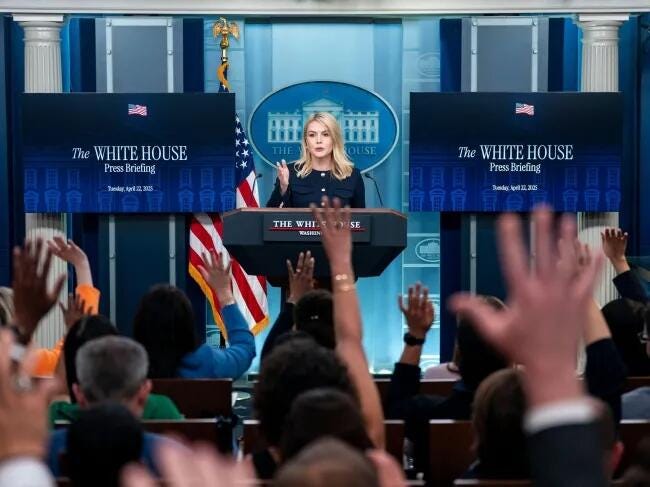
With out getting religious it’s been written that the term “light” as in daylight is the second most L-word in the bible.
You should be able to guess the first.
Keep that in mind when, to use just one example, you think about the fall of communism and the Berlin Wall. Another example is what happens in the dark will one day find the light.
Four years of Biden’s gangster corruption not to forget the horrible Obama years proves the point.
Light is cleansing. Darkness most of us already understand.
Trump’s change is the classic example of an old truism: “What’s good for the goose is good for the gander!”
In short, how do you like it now?
“One of the reasons the American political establishment really hates it when Trump is president is that his administration has a tendency to bring out and exaggerate dynamics at play in Washington, DC that the establishment would prefer to keep hidden.
“One such example is the weaponization of media access.
Right at the beginning of this term, Trump’s team shook things up by announcing that, going forward, they would control which journalists were allowed into White House press briefings and would determine where each would sit.
“Establishment journalists did little to hide their displeasure as the administration brought right-wing news sites, podcasters, and influencers to briefings that had always been reserved for “respectable” outlets. They characterized it as Trump shattering a decades-long tradition of media independence to prop up media figures loyal to him.
“The anger with Trump’s shake-up came to a head when the administration banned the Associated Press (AP) from White House Briefings after the news wire service refused to call the Gulf of Mexico by its new official name, the Gulf of America.
“As a result of that ban, which has mostly held up in court, many are trying to portray the president’s approach to the press pool as a brand-new form of authoritarianism that Trump has only recently introduced to Washington.
“But that isn’t true. Granting, controlling, and revoking access to official briefings, restricted government facilities, and the sites of government activities has been one of the political establishment’s favorite tools of media control for over a century.
“An urban legend says that the White House press pool was formed one night in 1900 when President Theodore Roosevelt noticed a group of reporters struggling to find sources outside in the rain and invited them into the White House.
“The story is likely not true. But still, the imagery of a president inviting struggling journalists in from a cold rainy night and giving them access to the White House is perfect symbolism for the government’s approach to the press. It appears benevolent and, on the surface, seems to embody the democratic principle of transparency. But by bringing certain journalists in, excluding others, and retaining the power to revoke access, the government gained leverage and control over much of the press.
“Not all presidents shared Roosevelt’s approach to media control. Woodrow Wilson, for instance, was famously unwilling to engage directly with reporters. And when his administration needed to crack down on anti-war rhetoric to ensure enough of the public would accept the American entrance into World War I, Wilson used strong-arm tactics like intimidation, suppression, and even imprisonment against journalists and media figures who continued to oppose the war.
“But as the years went on and Americans grew increasingly horrified by the naked authoritarianism overtaking Europe, a new appreciation for Roosevelt’s approach took root. Unlike the regimes in Berlin and Moscow, the American political class came to understand that the key to good media censorship does not lie in muzzling the media “watchdogs” but in transforming them into lapdogs.
“So, in the 1950s, President Eisenhower formally established the White House press pool as it is known today. Because of limited space, an “independent” organization called the White House Correspondents’ Association (WHCA) was tapped to formally choose the rotating roster of outlets and journalists that would get access to briefings.
“But the independence of this process was an illusion because the White House had complete control over which outlets were eligible to be chosen by the WHCA in the first place. And they would charge participating media organizations hefty fees when traveling with the president on government aircraft. This is presented as a way to protect the taxpayer, but it just so happens to ensure that only a few very wealthy corporate media outlets have been able to accompany presidents on trips.
“Together with the government’s seizure of the airwaves, the selective access the White House granted through the press pool gave the federal government considerable control over which newspapers and broadcasters gained prominence in the American media landscape.
“But there was still room to go. During the Vietnam War, White House officials grew frustrated that American journalists were roaming the country, writing stories that contradicted what officials were saying about the progress of the war.
“So in 1991, when the US again found itself in a major war, the government did the media the “favor” of granting them access to an official, government-sanctioned media center near the Iraqi border where they were fed information officials wanted the public to know. Then, occasionally, some of those journalists would get to join American troops and tour specific areas on and around the front lines.” Source



